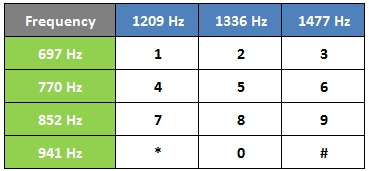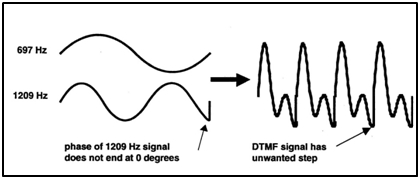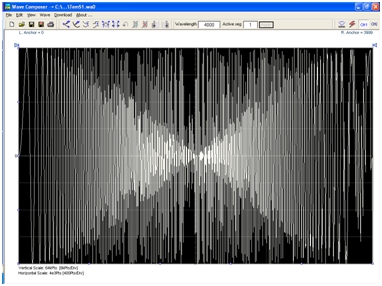Relevant Documents
 (201KB)
(201KB)
Background
DTMF (Dual-Tone Multi Frequency), or “touch-tone” signaling, was developed as a handset-to-switchboard signaling system for use over analog telephone lines. Using DTMF, a key press results in the generation of 2 tones using distinct frequencies, with a different combination representing each key. DTMF signaling is widely used in telephony and IVR (interactive voice response) applications. A table of frequencies and encoding combinations appears in Table 1 below.

Table 1: DTMF Frequency Encoder
Requirement
DTMF-based systems must be able to function reliably over noisy transmission lines. In testing these systems, it is necessary to add noise to simulate the worst-case signal quality that the systems are required to support.
A sophisticated waveform generator is required to test DTMF systems. The generator must be capable of performing the following functions:
Sine wave addition and cycle adjustment. The two sine waves must be summed and programmed to complete their cycles at or near the same phase. Take, for example, the encoding of the “1” key, which uses the 697 Hz and 1209 Hz frequencies. Because the two waves are not harmoni¬cally related, a problem arises with the phase relationship of the two signals when created over a single cycle, as shown in Figure 1 below.

Figure 1: Out-of-Phase DTMF Cycles
In order to solve the problem, we must define the number of cycles for each frequency that will result in a zero (or close to zero) degree phase differential. In the case of the “1” key, 15 cycles at 697 Hz and 26 cycles at 1209 Hz yield a differential of 3 degrees only.
Storage of Segments. The waveform generator should offer memory management technology that supports the storage of the waveforms created. In the case of DTMF, 12 segments are stored and recalled for use in subsequent tests.
Noise Generation. The waveform generator must be able to generate the noise needed to simulate disturbances in the communications line.
Solution
Tabor Electronics’ Wonder Wave family of Arbitrary Waveform Generators (AWGs) provide telephony and IVR equipment manufacturers with an outstanding platform for the testing of DTMF-based systems.
- Highly-flexible wave generation.Tabor’s Windows-based ArbConnnection provides easy, intuitive waveform creation and editing. You can leverage its powerful Waveform Composer tool to generate unique, arbitrary waveforms that simulate noise of any kind.

Figure 2: Wave Composer
- Powerful memory management. Wonder Wave supports highly complex applications, offering storage of 10,000 repeatable waveform segments, with up to 4 million memory points.
For More Information
To learn more about Tabor’s solutions or to schedule a demo, please contact your local Tabor representative or email your request to [email protected]